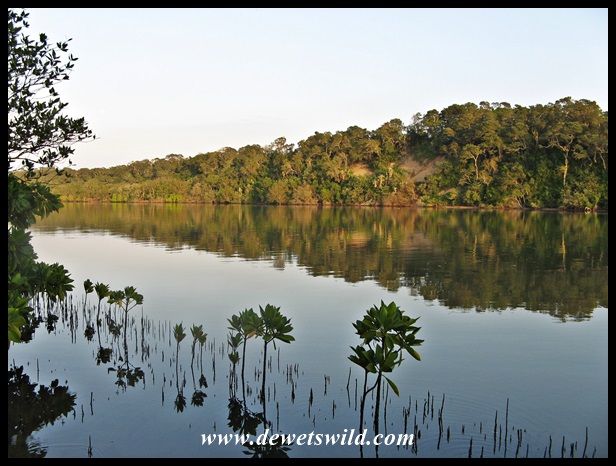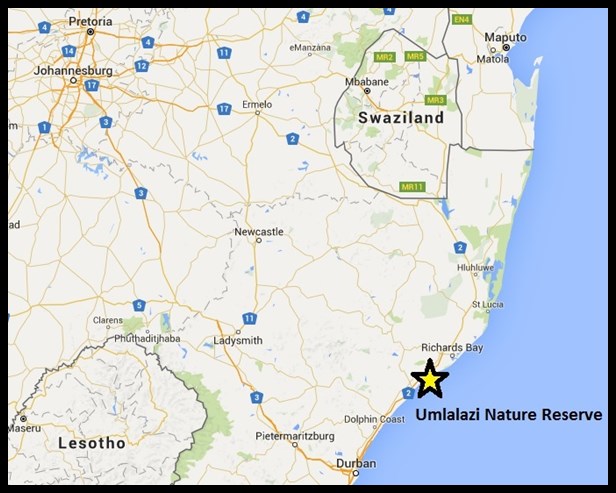We found a treasure along the Kwazulu-Natal Coast!
We had looked forward to our first visit to Umlalazi Nature Reserve in March with great excitement, but what we found at this little jewel exceeded our expectations many times over.
Compared to many other South African conservation areas, Umlalazi is tiny. The reserve may cover only a little over 1000ha, but it is the amazing diversity of ecosystems it protects that make it such a valuable piece of land. The estuary of the Mlalazi River is considered among the top 20 most important to conserve of more than 250 South African estuaries. Another watercourse, the Siyayi, runs parallel to the sea for a distance of about 8km through the reserve, though only reaches the ocean after episodes of extreme rainfall as its mouth has been blocked by the dunes at Umlalazi’s main beach. The reserve is well known for the excellent examples of mangrove forests it protects, but you’ll also find swamp forests dominated by Swamp Fig trees (Ficus trichopoda), climax dune forests, Acacia thickets, tidal salt marshes, freshwater wetlands, coastal grasslands, seashore dune vegetation as well as miles of unspoiled beaches. A grove of Kosi Palms (Raphia australis), one of the largest species of palm in the world, was planted in 1903 by a magistrate C.C. Foxon and is today regarded a national monument.
Of course, with such a huge diversity of habitats it should come as no surprise that Umlalazi is home to an equally impressive variety of animal life. The abundance of invertebrate species of all descriptions is simply astounding. Thirteen mammal species have been recorded, with plains zebra, red duiker and vervet monkey being the most easily seen. The critically endangered Pickersgill’s Reed Frog is among 15 species of amphibians found in the reserve, while nile crocodile, python and gaboon adder feature in the list of 16 reptile species – 9 of which snakes – you might encounter. With a list of 327 bird species identified, the reserve is a prime destination for birdwatchers – pride of place of course going to the southern most breeding population of Palmnut Vultures that feed and nest in the Kosi Palms. These small vultures (wingspan of 1.5m, weight up to 1.8kg) is one of South Africa’s rarest birds, but regularly encountered here at Umlalazi, and apart from the fruit of the palms will also feed on carrion and small animals.
These three zebras seemed to act as our hosts while we were visiting Umlalazi and regularly passed by. They even formed a guard of honour at the gate when we departed 😀
In upcoming posts, we’ll focus some more attention on Umlalazi’s mangroves, the estuary, the forests and the beach.
The focus for Umlalazi’s human visitors is on outdoor recreation, with fishing, boating, canoeing (can be hired at reception), hiking, birding, swimming, surfing and picnicking being popular pursuits. Excellent information displays at the trail heads and other public areas give visitors an insight into the world they are exploring.
The reserve is managed by Ezemvelo KZN Wildlife, through whom overnight visitors can also book the twelve fully self-contained 4-sleeper log cabins, the 14 camping sites at Indaba Camp or the 36 camping sites at Inkwazi Camp available inside the reserve. The town of Mtunzini, just outside the reserve gates, also offers several alternative accommodation options, as well as a variety of other services you’d expect in a small holiday town. The area’s modern history dates back to the 1850’s when the colourful character John Robert Dunn settled here. Dunn befriended Zulu King Cetshwayo who appointed him Chieftain over the area that Umlalazi and Mtunzini lies in today. He held his court and celebrations under a large red milkwood tree (known as the Indaba Tree) in what is now the Indaba campsite at Umlalazi. Dunn died in 1895, having married 49 wives (48 of which according to traditional Zulu custom) and fathering over a hundred children (various sources give differing numbers about exactly how many – ranging from 116 to 163!). That same year, a magistrate was appointed at Mtunzini, marking the official birth of the town. Umlalazi Nature Reserve itself was proclaimed in 1948 and today forms the northernmost section of the Siyaya Coastal Park which stretches for 37km along the coastline and also incorporates the Redhill and Amatigulu Nature Reserves.
Umlalazi Nature Reserve is located on the Indian Ocean, along Kwazulu-Natal’s North Coast about 140km from Durban (or 700km from Pretoria), and easily accessed from the Mtunzini off-ramp from the N2-highway.
















































Reblogged this on Roaring Reservations.
LikeLike
Excellent post! No hippo’s??
LikeLiked by 1 person
Thanks Maurice! Sadly no hippos – they would have been very numerous in days gone by, but I don’t think the wider, modern-day Mtunzini area would have enough grazing to sustain them now.
LikeLike
Pretty amazing place
LikeLiked by 1 person
Dynamite in a small package for sure!
LikeLike
Gorgeous photos, Dries. Love those zebras. 🙂
LikeLiked by 1 person
Thanks Sylvia! Did you visit Umlalazi?
LikeLiked by 1 person
No, we haven’t ever been there, but my sister has told us about it. 🙂
LikeLiked by 1 person
Next time then!
LikeLiked by 1 person
Sjoe, die een is mooier as die ander
LikeLiked by 1 person
Dankie Tina!
LikeLiked by 1 person
Exactly the kind of small but special place I love. I bet it’s interesting to go out at night looking for critters on the prowl, and bring your macro lens!
LikeLiked by 1 person
Absolutely Michael! Though I must admit that I was a bit nervous when I found a bushpig in the spotlight as they can be rather cantankerous – I didn’t want to use the flash to get a photograph for fear of a charge in retaliation 😀
LikeLike
I love the honor guard. They know friends when they see them! 😀
LikeLiked by 1 person
It certainly brought a smile to our faces, Lois. We wondered where they were when we got up that morning and then to find them waiting to say goodbye at the gate was so special!
LikeLike
Thanks for sharing. That does look like a little gem
LikeLiked by 1 person
Definitely worth a visit if you’re ever in the area, Cal!
LikeLike
Baie interessant,Dries.Ek het hierdie week egter die onrusbare nuus gehoor dat Ezemvelo se kontrak om die KZN reservate en beskerming van die oseaan nie meer verleng gaan word nie.Hoe interpreteer jy dit en moet ons ongelukkig voel daaroor?
LikeLiked by 1 person
Ja-Nee Dina, die politiek agter sulke besluite bly maar duister. Ezemvelo KZN Wildlife, voorheen die Natalse Parkeraad, patrolleer al baie jare KZN se kus en sover ek kon agterkom was daar geen kommer oor die kwaliteit van hul werk nie en meeste kenners en belanghebbendes het met skok op die besluit reageer. Geen van die artikels wat ek gesien het gee eintlik enige tersaaklike redes vir die beeindiging van hul dienste nie. Hul is immers n staatsorganisasie, hoewel onder provinsiale beheer. Nou moet die nasionale departement oorneem met hul karige hulpbronne? Ek dink veral in die oorgangsfase gaan daar n paar skurke deur die net glip. Sover ek egter kan agterkom is hul beheer or die proklameerde reservate in die binneland en langs die kus onder hul bestuur, soos Umlalazi, egter nie in gedrang nie.
LikeLiked by 1 person
Sulke besluite laat my altyd dink iemand het iewers ‘n agenda…bv stropery van seebronne soos oesters en haaie vir die Sjinese se haaivindisse.Ek is deesdae baie agterdogtig oor hierdie mense.Ekskuus Dries,ek klink nou negatief,maar hierdie volg ‘n patroon wat ons gereeld sien,waar onwettighede dan ‘n vastrapplek kry.
LikeLiked by 1 person
Nee Dina, ek stem heelhartig saam – wanneer n bewaringsorganisie wat wereldwyd as van die bestes gereken word, met n trotste geskiedenis en n bewese suksesresep so skielik en sonder ooglopende gronde die trekpas kry, kan mens nie anders as om te wonder nie.
LikeLiked by 1 person
Kan hulle dalk apelleer of hof toe gaan oor die besluit?
LikeLike
Ek dink nie ek het al enige reaksie van Ezemvelo KZN Wildlife self gesien, of iets gelees oor wat hul planne is nie.
LikeLiked by 1 person
Ek hoop hulle is besig met iets…laat ons intussen positief bly en die natuur saam met jou geniet.
LikeLiked by 1 person
Have been looking at going for some time now, thx guys
LikeLiked by 1 person
Great to hear from you again, Killaval – hope you are well?
We originally booked this trip at Umlalazi because we couldn’t get a booking at Cape Vidal, but in future it will be a hard decision which of them to go for first!
LikeLike
Looks like another amazing place. I think the Giant Snail picture is my favorite!
LikeLiked by 1 person
We were astounded by all there was to see and experience at Umlalazi, Kathy!
LikeLike
Beautiful!
LikeLiked by 1 person
Thanks Gayle, Umlalazi’s a beautiful place for sure!
LikeLike
Great overview, looking forward to hearing more. That “gang” of vervets looks like mischief afoot. Are they good at getting into things? 🙂
LikeLiked by 1 person
They’re extremely naughty Pat! Leave open a car’s window or your kitchen door and they’ll help themselves to any visible food in a flash. The problem is compounded when people feed them on purpose, they then start hanging out around picnic areas expecting handouts and get very agitated if you don’t want to share…
LikeLiked by 1 person
This is a wonderfully diverse place. I especially like your sunset shot.
LikeLiked by 1 person
Thank you Patti! Yes indeed, for a place so small in area there’s an amazing variety at Umlalazi.
LikeLiked by 1 person
I laughed after seeing the sign saying “danger crocodiles” then see folks on tubes! Tourists!! Ha ha!
LikeLiked by 1 person
While out walking one afternoon I actually found a group of children swimming right behind that exact sign while their parents were picnicking on the bank. They may have been Mtunzini-residents more familiar with the area than me, perhaps they knew how often or not crocodiles are seen at that particular spot. I sincerely hope so, because nile crocodiles are extremely dangerous.
LikeLiked by 1 person
Nou het ek weer lekker gekuier! Dankie!! 😉
LikeLiked by 1 person
Altyd lekker om jou saam te vat AJ!
LikeLike
Darem maar n pragtige plek met n groot verskeidenheid plant en dierelewe. Mangrove het ek nog nooit werklik gesien nie. Dit hou vir my so n geheimsinnigheid in. Pill-millipede is n mooi duidelike foto. Die akkedis wat loer is netso mooi. Ek kuier darem altyd te lekker by julle of saam met julle.
LikeLiked by 1 person
En ons geniet dit om jou saam te he, Ineke! Daar’s n wonderlike “boardwalk” deur n stukkie van Umlalazi se wortelboommoerasse wat mens n fantastiese blik daarop gee – meer daaroor een van die dae!
LikeLike
Aa dankie ek sien uit daarna.
LikeLiked by 1 person
Absolute heaven 😀
LikeLiked by 1 person
That’s a great description, thanks Joan!
LikeLiked by 1 person
Ons het baie keer die skoolkinders daarheen geneem vir uitstappies! ( dis toe ek nog skoolgehou het)
LikeLiked by 1 person
Onthou jy Umlalazi ook met n glimlag, Aletta?
LikeLiked by 1 person
Ja! want ‘n vlakvark het my in die kamp gejaag!! Dit was nie snaaks op daardie oomblik nie!! Die kinders het dit natuurlik van harte geniet!! 😀
LikeLiked by 1 person
Ek kan dink dat dit nogal angswekkend was Aletta, bosvarke laat nie met hulle mors nie!
LikeLiked by 1 person
wonderful, bravo………..the monkeys so cute ans you knew you had me at the zebras 🙂
LikeLiked by 1 person
Thank you Julz! Umlalazi’s zebra-threemanship were a real treat to the visitors, they’re just so relaxed around people!
LikeLiked by 1 person